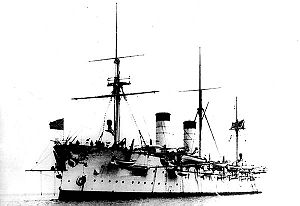Russian cruiser Rurik (1892)
 |
|
| History | |
|---|---|
|
|
|
| Name: | Rurik |
| Namesake: | Rurik |
| Builder: | Baltic Works, Russia |
| Laid down: | 19 May 1890 |
| Launched: | 22 October 1892 |
| Commissioned: | May 1895 |
| Fate: | Scuttled – 14 August 1904 |
| General characteristics | |
| Type: | Armoured cruiser |
| Displacement: |
|
| Length: | 412 ft (125.6 m) |
| Beam: | 67 ft (20.4 m) |
| Draught: | 26 ft (7.9 m) |
| Installed power: |
|
| Propulsion: | 2 shafts; 2 vertical triple-expansion steam engines |
| Speed: | 18 knots (33 km/h; 21 mph) |
| Range: | 6,700 nmi (12,400 km; 7,700 mi) at 10 knots (19 km/h; 12 mph) |
| Complement: | 719 officers and crewmen |
| Armament: |
|
| Armour: |
|
Rurik (Russian: Рюрик) was an armoured cruiser built for the Imperial Russian Navy in the 1890s. She was named in honour of Rurik, the semi-legendary founder of ancient Russia. She was sunk at the Battle of Ulsan in the Russo-Japanese War of 1904–05.
The Imperial Russian Navy, by the end of the 19th century required a cruiser capable of undertaking long cruises into foreign waters for the purpose of destroying commercial vessels, especially if war was to occur between Russia and the United Kingdom. Russian admiral Ivan Shestakov submitted the design of Rurik to the Baltic Works at St. Petersburg for construction, bypassing the normal procedure of submitting the design to the Naval Technical Committee (MTK). The original specifications for the vessel, as submitted by Shestakov, are currently lost, but presumably Shestakov intended the ship to be able to travel from "the Baltic to Vladivostok without recoaling en route". It appears that Shestakov wanted a design similar to Pamiat Azova and such a design was submitted via a constructor from the Baltic Works to the MTK.
That design, a 9,000-ton, 8 inch belted cruiser, was rejected by the MTK. It is more likely that the design was rejected because of tension between Shestakov and the MTK and the General Admiral of the Navy, Grand Duke Alexei Alexandrovich, rather than technical issues with the design. The submitted design called for a long warship (over 400 feet (120 m)) and had a design endurance of 20,000 nautical miles (37,000 km). Shestakov was unable, however, to fight for the submitted design, as he died in December 1888.
...
Wikipedia
